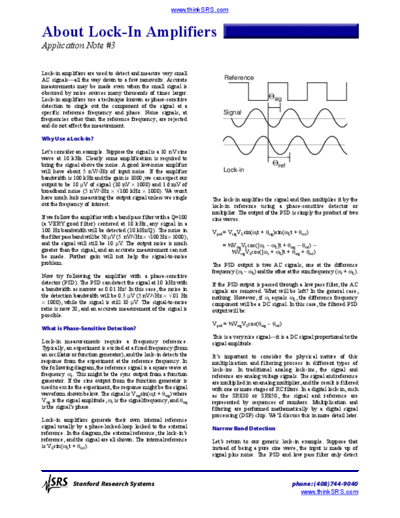Service Manuals, User Guides, Schematic Diagrams or docs for : Stanford Research Systems www.thinksrs.com-AboutLIAs
<< Back | HomeMost service manuals and schematics are PDF files, so You will need Adobre Acrobat Reader to view : Acrobat Download Some of the files are DjVu format. Readers and resources available here : DjVu Resources
For the compressed files, most common are zip and rar. Please, extract files with Your favorite compression software ( WinZip, WinRAR ... ) before viewing. If a document has multiple parts, You should download all, before extracting.
Good luck. Repair on Your own risk. Make sure You know what You are doing.
Image preview - the first page of the document

>> Download www.thinksrs.com-AboutLIAs documenatation <<
Text preview - extract from the document
www.thinkSRS.com About Lock-In Amplifiers Application Note #3 Lock-in amplifiers are used to detect and measure very small AC signalsall the way down to a few nanovolts. Accurate Reference measurements may be made even when the small signal is obscured by noise sources many thousands of times larger. Lock-in amplifiers use a technique known as phase-sensitive sig detection to single out the component of the signal at a specific reference frequency and phase. Noise signals, at Signal frequencies other than the reference frequency, are rejected and do not affect the measurement. Why Use a Lock-In? Let's consider an example. Suppose the signal is a 10 nV sine wave at 10 kHz. Clearly some amplification is required to bring the signal above the noise. A good low-noise amplifier ref will have about 5 nV/Hz of input noise. If the amplifier Lock-in bandwidth is 100 kHz and the gain is 1000, we can expect our output to be 10
◦ Jabse Service Manual Search 2024 ◦ Jabse Pravopis ◦ onTap.bg ◦ Other service manual resources online : Fixya ◦ eServiceinfo